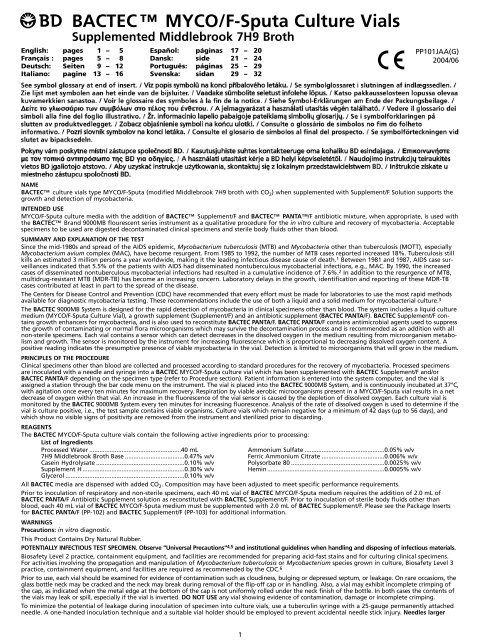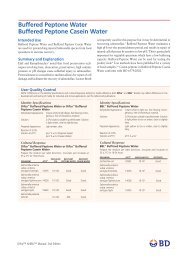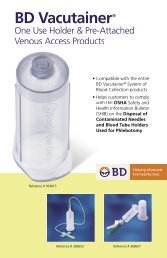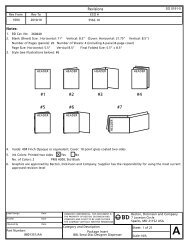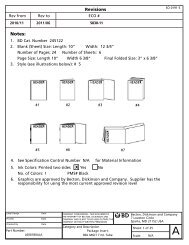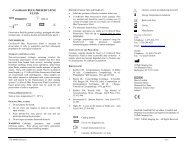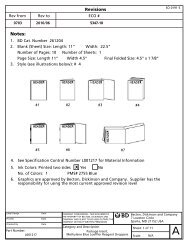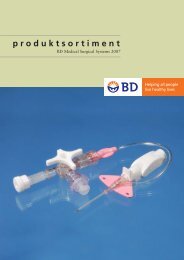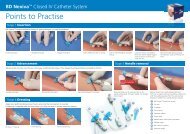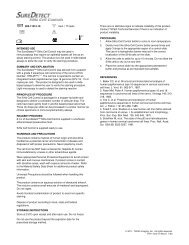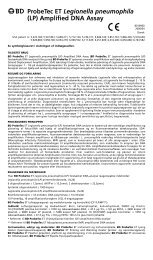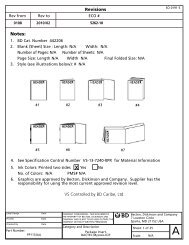BACTEC MYCO/F-Sputa Culture Vials - BD
BACTEC MYCO/F-Sputa Culture Vials - BD
BACTEC MYCO/F-Sputa Culture Vials - BD
Create successful ePaper yourself
Turn your PDF publications into a flip-book with our unique Google optimized e-Paper software.
PP101G(0604).qxd 09/09/2004 11:06 AM Page 1<br />
<strong>BACTEC</strong> <strong>MYCO</strong>/F-<strong>Sputa</strong> <strong>Culture</strong> <strong>Vials</strong><br />
Supplemented Middlebrook 7H9 Broth<br />
English: pages 1 – 5 Español: páginas 17 – 20<br />
Français : pages 5 – 8 Dansk: side 21 – 24<br />
Deutsch: Seiten 9 – 12 Português: páginas 25 – 29<br />
Italiano: pagine 13 – 16 Svenska: sidan 29 – 32<br />
NAME<br />
<strong>BACTEC</strong> culture vials type <strong>MYCO</strong>/F-<strong>Sputa</strong> (modified Middlebrook 7H9 broth with CO2 ) when supplemented with Supplement/F Solution supports the<br />
growth and detection of mycobacteria.<br />
INTENDED USE<br />
<strong>MYCO</strong>/F-<strong>Sputa</strong> culture media with the addition of <strong>BACTEC</strong> Supplement/F and <strong>BACTEC</strong> PANTA/F antibiotic mixture, when appropriate, is used with<br />
the <strong>BACTEC</strong> Brand 9000MB flourescent series instrument as a qualitative procedure for the in vitro culture and recovery of mycobacteria. Acceptable<br />
specimens to be used are digested decontaminated clinical specimens and sterile body fluids other than blood.<br />
SUMMARY AND EXPLANATION OF THE TEST<br />
Since the mid-1980s and spread of the AIDS epidemic, Mycobacterium tuberculosis (MTB) and Mycobacteria other than tuberculosis (MOTT), especially<br />
Mycobacterium avium complex (MAC), have become resurgent. From 1985 to 1992, the number of MTB cases reported increased 18%. Tuberculosis still<br />
kills an estimated 3 million persons a year worldwide, making it the leading infectious disease cause of death. 1 Between 1981 and 1987, AIDS case surveillances<br />
indicated that 5.5% of the patients with AIDS had disseminated nontuberculous mycobacterial infections, e.g., MAC. By 1990, the increased<br />
cases of disseminated nontuberculous mycobacterial infections had resulted in a cumulative incidence of 7.6%. 2 In addition to the resurgence of MTB,<br />
multidrug-resistant MTB (MDR-TB) has become an increasing concern. Laboratory delays in the growth, identification and reporting of these MDR-TB<br />
cases contributed at least in part to the spread of the disease.<br />
The Centers for Disease Control and Prevention (CDC) have recommended that every effort must be made for laboratories to use the most rapid methods<br />
available for diagnostic mycobacteria testing. These recommendations include the use of both a liquid and a solid medium for mycobacterial culture. 3<br />
The <strong>BACTEC</strong> 9000MB System is designed for the rapid detection of mycobacteria in clinical specimens other than blood. The system includes a liquid culture<br />
medium (<strong>MYCO</strong>/F-<strong>Sputa</strong> <strong>Culture</strong> Vial), a growth supplement (Supplement/F) and an antibiotic supplement (<strong>BACTEC</strong> PANTA/F). <strong>BACTEC</strong> Supplement/F contains<br />
growth enhancers for mycobacteria, and is also used to reconstitute <strong>BACTEC</strong> PANTA/F. <strong>BACTEC</strong> PANTA/F contains antimicrobial agents used to suppress<br />
the growth of contaminating or normal flora microorganisms which may survive the decontamination process and is recommended as an addition with all<br />
non-sterile specimens. Each vial contains a sensor which can detect decreases in the dissolved oxygen in the medium resulting from microorganism metabolism<br />
and growth. The sensor is monitored by the instrument for increasing fluorescence which is proportional to decreasing dissolved oxygen content. A<br />
positive reading indicates the presumptive presence of viable mycobacteria in the vial. Detection is limited to microorganisms that will grow in the medium.<br />
PRINCIPLES OF THE PROCEDURE<br />
Clinical specimens other than blood are collected and processed according to standard procedures for the recovery of mycobacteria. Processed specimens<br />
are inoculated with a needle and syringe into a <strong>BACTEC</strong> <strong>MYCO</strong>/F-<strong>Sputa</strong> culture vial which has been supplemented with <strong>BACTEC</strong> Supplement/F and/or<br />
<strong>BACTEC</strong> PANTA/F depending on the specimen type (refer to Procedure section). Patient information is entered into the system computer, and the vial is<br />
assigned a station through the bar code menu on the instrument. The vial is placed into the <strong>BACTEC</strong> 9000MB System, and is continuously incubated at 37°C,<br />
with agitation once every ten minutes for maximum recovery. Respiration by viable aerobic microorganisms present in a <strong>MYCO</strong>/F-<strong>Sputa</strong> vial results in a net<br />
decrease of oxygen within that vial. An increase in the fluorescence of the vial sensor is caused by the depletion of dissolved oxygen. Each culture vial is<br />
monitored by the <strong>BACTEC</strong> 9000MB System every ten minutes for increasing fluorescence. Analysis of the rate of dissolved oxygen is used to determine if the<br />
vial is culture positive, i.e., the test sample contains viable organisms. <strong>Culture</strong> vials which remain negative for a minimum of 42 days (up to 56 days), and<br />
which show no visible signs of positivity are removed from the instrument and sterilized prior to discarding.<br />
REAGENTS<br />
The <strong>BACTEC</strong> <strong>MYCO</strong>/F-<strong>Sputa</strong> culture vials contain the following active ingredients prior to processing:<br />
List of Ingredients<br />
Processed Water ......................................................40 mL Ammonium Sulfate ...............................................0.05% w/v<br />
7H9 Middlebrook Broth Base ...................................0.47% w/v Ferric Ammonium Citrate .....................................0.006% w/v<br />
Casein Hydrolysate ....................................................0.10% w/v Polysorbate 80 .......................................................0.0025% w/v<br />
Supplement H ............................................................0.30% w/v Hemin .....................................................................0.0005% w/v<br />
Glycerol ......................................................................0.10% w/v<br />
All <strong>BACTEC</strong> media are dispensed with added CO2 . Composition may have been adjusted to meet specific performance requirements.<br />
Prior to inoculation of respiratory and non-sterile specimens, each 40 mL vial of <strong>BACTEC</strong> <strong>MYCO</strong>/F-<strong>Sputa</strong> medium requires the addition of 2.0 mL of<br />
<strong>BACTEC</strong> PANTA/F Antibiotic Supplement solution as reconstituted with <strong>BACTEC</strong> Supplement/F. Prior to inoculation of sterile body fluids other than<br />
blood, each 40 mL vial of <strong>BACTEC</strong> <strong>MYCO</strong>/F-<strong>Sputa</strong> medium must be supplemented with 2.0 mL of <strong>BACTEC</strong> Supplement/F. Please see the Package Inserts<br />
for <strong>BACTEC</strong> PANTA/F (PP-102) and <strong>BACTEC</strong> Supplement/F (PP-103) for additional information.<br />
WARNINGS<br />
Precautions: in vitro diagnostic.<br />
This Product Contains Dry Natural Rubber.<br />
POTENTIALLY INFECTIOUS TEST SPECIMEN. Observe “Universal Precautions” 4,5 and institutional guidelines when handling and disposing of infectious materials.<br />
Biosafety Level 2 practice, containment equipment, and facilities are recommended for preparing acid-fast stains and for culturing clinical specimens.<br />
For activities involving the propagation and manipulation of Mycobacterium tuberculosis or Mycobacterium species grown in culture, Biosafety Level 3<br />
practice, containment equipment, and facilities are required as recommended by the CDC. 6<br />
Prior to use, each vial should be examined for evidence of contamination such as cloudiness, bulging or depressed septum, or leakage. On rare occasions, the<br />
glass bottle neck may be cracked and the neck may break during removal of the flip-off cap or in handling. Also, a vial may exhibit incomplete crimping of<br />
the cap, as indicated when the metal edge at the bottom of the cap is not uniformly rolled under the neck finish of the bottle. In both cases the contents of<br />
the vials may leak or spill, especially if the vial is inverted. DO NOT USE any vial showing evidence of contamination, damage or incomplete crimping.<br />
To minimize the potential of leakage during inoculation of specimen into culture vials, use a tuberculin syringe with a 25-gauge permanently attached<br />
needle. A one-handed inoculation technique and a suitable vial holder should be employed to prevent accidental needle stick injury. Needles larger<br />
1<br />
! PP101JAA(G)<br />
2004/06


